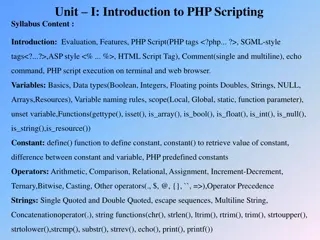
Dynamic Programming Solutions for Homework Challenges
Explore dynamic programming solutions for various homework questions including knapsack problems and the Tower of Hanoi puzzle. Learn about feasibility checks, content retrieval, and algorithm modifications. Dive into the world of problem-solving through step-by-step visual representations and code snippets.
Download Presentation

Please find below an Image/Link to download the presentation.
The content on the website is provided AS IS for your information and personal use only. It may not be sold, licensed, or shared on other websites without obtaining consent from the author. If you encounter any issues during the download, it is possible that the publisher has removed the file from their server.
You are allowed to download the files provided on this website for personal or commercial use, subject to the condition that they are used lawfully. All files are the property of their respective owners.
The content on the website is provided AS IS for your information and personal use only. It may not be sold, licensed, or shared on other websites without obtaining consent from the author.
E N D
Presentation Transcript
Knapsack_Output (n, S, K, P) 1 begin 2 if!P[n, K].exist then 3 print no solution 4 else 5 i := n; 6k := K; 7 while k > 0 do 8 if P[i, k].belong = true then 9 print S[i]; 10 k := k - S[i]; 11 i := i 1; 12 end
Modifications Algorithm Knapsack (S, K); 1 begin 2 P[0, 0].exist := true; 3 P[0, 0].belong := 0; 4 for k := 1 to K do 5 P[0, k].exist := false; 6 for i := 1 to n do 7 for k := 0 to K do 8 P[i, k].exist := false; 9 if P[i 1, k]:exist then 10 P[i, k].exist := true; 11 P[i, k].belong := 0; 12 else if k - S[i] 0 then 13 if P[i, k - S[i]].exist then 14 P[i, k].exist := true; 15 P[i, k].belong := 16 P[i, k - S[i]].belong + 1; 17 end 0 1 2 3 4 5 6 0 - - - - - - k1=2 k2=3 0 - 1 - 2 - 3 0 - 0 1 0 1 0
How to check the feasibility? If S is even See if P[ n, ? 2].exist is true or not.
How to get the contents? if S is odd{ } else{ print mission impossible let y = ? Build knapsack table P[n, y] if (P[ n, ? ].exist){ while(? > 0){ } } else{ print mission impossible } } 2 if (P[ n, ? ].belong){ }else{ } n-- put ?? in the set 1 y -= ?? put ?? in the set 2
(a) Algorithm Hanoi(n, A, B, C); 1 begin 2 if n=1 then 3 move from A to B 4 else if n>1 5Hanoi(n-1, A, C, B); 6 move the largest disk from A to B 7 Hanoi(n-1, C, B, A); 8 end Base case: 1 disk (move from A to B) Inductive step: To move n disks, Induction hypothesis: Moving n-1 disks is available (1) move n-1 disks from A to C (induction hypothesis) (2) move the largest disk to B (base case) (3) move n-1 disk from C to B (induction hypothesis)
(b) Let S(n) be the total number of moves for Hanoi puzzle with size n S(1)=1 S(n)=2*S(n-1)+1 , n 2 S(1)+1=2 S(2)+1=2*(S(1)+1) x) S(n)+1=2*(S(n-1)+1) S(n)+1=2n => S(n)=2n -1
Pseudocode Define the left pole as source pole, the middle one as auxiliary pole, and the right one as destination pole. Total step of moving n disk in Hanoi problem is 2? 1 If n%2 == 0 change the role of middle one and right one for i := 1 to 2? 1 if i%3 == 1 make a legal movement of the top disk between source pole and destination pole if i%3 == 2 make a legal movement of the top disk between source pole and auxiliary pole if i%3 == 0 make a legal movement of the top disk between auxiliary pole and destination pole
Program 1. 2. 3. hw5 4. input output 5. Building 6. error, exception, invalid input 7. 8. compile Makefile
Input (c++ case) int main(int argc, char **argv){ ifstream in(argv[1]); streambuf *cinbuf = cin.rdbuf(); cin.rdbuf(in.rdbuf()); // //( input cin cout) cin.rdbuf(cinbuf); return 0; }
Documentation 1. 2. 3. 1. ( ) 2. ( ) 3. ( )






















